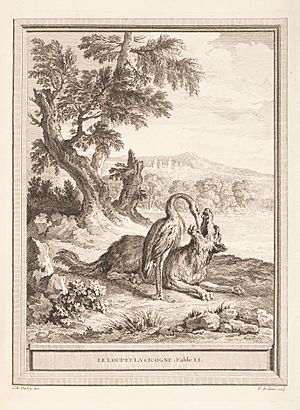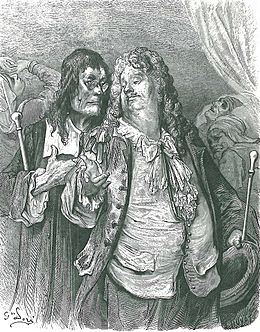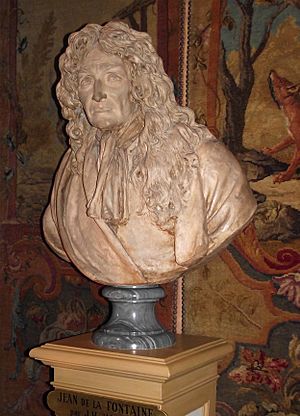Jean de La Fontaine facts for kids
Quick facts for kids
Jean de La Fontaine
|
|
|---|---|

Portrait by Hyacinthe Rigaud
(Carnavalet Museum) |
|
| Born | 8 July 1621 Château-Thierry, Champagne, France |
| Died | 13 April 1695 (aged 73) Neuilly-sur-Seine, Île-de-France, France |
| Resting place | Père Lachaise Cemetery |
| Occupation | Fabulist, poet |
| Children | 1 |
Jean de La Fontaine (born July 8, 1621 – died April 13, 1695) was a famous French fabulist and poet. He is best known for his amazing Fables. These stories, often featuring animals, taught important lessons and became very popular. They inspired many other writers across Europe.
Even after some time when the king was suspicious of him, La Fontaine became a member of the French Academy. His fame in France has lasted ever since. You can see his importance in the many pictures, statues, medals, coins, and stamps made in his honor.
Contents
Life Story of Jean de La Fontaine
Growing Up and Early Life
Jean de La Fontaine was born in Château-Thierry, France. His father, Charles de La Fontaine, was like a deputy-ranger for the Duchy of Château-Thierry. His mother was Françoise Pidoux. Both sides of his family were well-off middle-class people.
Jean was the oldest child. He went to grammar school in Château-Thierry. After school, he tried studying to become a priest, but he quickly realized it wasn't for him. Later, he studied law and became a lawyer.
Family and Home Life
In 1647, Jean's father gave him his ranger job. He also arranged for Jean to marry Marie Héricart, who was fourteen. She brought a good amount of money to the marriage. Marie was said to be beautiful and smart.
However, Jean and Marie did not get along very well. Jean was often away from home. He was also not very good at managing money. Because of this, their finances became complicated. In 1658, they decided to separate their money. This was a friendly agreement to help their family. Over time, they stopped living together. For most of his later life, La Fontaine lived in Paris. His wife stayed in Château-Thierry, though he often visited. They had one son in 1653, who was raised by his mother.
Life in Paris
La Fontaine started visiting Paris often, and by 1656, he was a regular visitor. His job as a ranger didn't require him to be in one place all the time. He didn't start his writing career until he was over thirty years old.
His first major work was a translation of a play called Eunuchus in 1654. At this time, a powerful official named Fouquet supported many writers. La Fontaine met Fouquet and soon received a regular payment from him. He also started writing a mix of prose and poetry about Fouquet's famous country house.
When Fouquet lost favor with the king and was arrested, La Fontaine showed his loyalty. He wrote a sad poem called Pleurez, Nymphes de Vaux (Weep, Nymphs of Vaux).
Around this time, La Fontaine's own money situation was not great. He had to sell some of his belongings. But he always found new powerful friends who helped him. He found a new supporter in the Duchess of Bouillon. She enjoyed the works of a poet named Ariosto, which might have inspired La Fontaine to write his first important book, the Contes (Tales), in 1664. He was forty-three years old then.
Becoming Famous

Around this time, a famous group of writers formed in Paris. It included La Fontaine, Racine, Boileau, and Molière. They often met and shared their ideas.
La Fontaine continued to make friends. In 1664, he became a gentleman to the Duchess of Orléans and lived in the Luxembourg Palace in Paris. He still had his ranger job. In 1666, he received a reminder to check on some problems in Château-Thierry.
In the same year, the second book of his Contes was published. In 1668, the first six books of his Fables came out. More of both kinds of works followed in 1671.
A year later, his situation changed. The Duchess of Orléans died, and he likely had to give up his ranger job. But La Fontaine was always lucky. Madame de la Sablière, a kind and intelligent woman, invited him to live in her house. He stayed there for about twenty years. He no longer had to worry about money and could focus on his poetry and plays.
Joining the Academy
In 1682, when he was over sixty, La Fontaine was seen as one of France's top writers. Many people loved his second collection of Fables, published in 1678. It was natural for him to want to join the Académie française, a famous French institution that protects the French language.
He was first suggested in 1682 but was not chosen. The next year, a powerful official named Colbert died, and La Fontaine was nominated again. Most members of the Academy were his friends. He was elected, but the king was not pleased at first. However, after another spot opened, La Fontaine officially became a member of the Académie française.
In 1692, La Fontaine published a new version of his Contes. That same year, he became very ill. He also had a religious conversion and became more devoted to Christianity. He continued to write poems and fables in his final years.
La Fontaine died on April 13, 1695, in Paris, at the age of seventy-three. His remains were later moved to the Père Lachaise Cemetery in Paris. His wife lived for almost fifteen years after him.
Jean de La Fontaine's Works
La Fontaine's many writings can be divided into three main types: his Fables, his Tales, and his other works, including plays. He is most famous for his Fables.
His second type of work, the Tales (Contes et nouvelles en vers), were also very popular for a long time. The first ones were published in 1664, and the last ones came out after he died.
How La Fontaine is Remembered
While La Fontaine's Fables are known worldwide, he is especially celebrated in France. Even when he was alive, three leading artists painted his portrait. Two sculptors also made busts (head and shoulders statues) of him. One of these busts is now at the Philadelphia Museum of Art, and another is at the castle of his old supporter, Fouquet, at Vaux-le-Vicomte.
In Paris, there is a full-size marble statue of him in the Louvre museum. This statue was made in 1781.
There are more statues in Château-Thierry, the town where he was born. The most important one is a standing statue, given to the town by King Louis XVIII. It was placed in a square overlooking the Marne river in 1824. At its base, you can see the famous race between the Tortoise and the Hare. La Fontaine's former house in Château-Thierry is now a museum. Outside the museum, there is a life-sized statue of him. Inside, you can see a clay bust of La Fontaine.
La Fontaine's lasting popularity is also shown by his image appearing on a playing card during the French Revolution. He was featured as the King of Spades.
His head also appeared on a 100-franc coin to celebrate 300 years since his death. On the other side of the coin, you can see the fable of the fox and the crow. In 1995, there were also postage stamps featuring his fables. The asteroid 5780 Lafontaine was named after him that same year.
Other postage stamps featuring La Fontaine include a 1938 stamp with a picture of The Wolf and the Lamb fable. In 1971, Monaco released a stamp for his 350th birthday, showing his head and some of his famous animal characters. He also appears on a series of coins celebrating the Chinese lunar new year, with his portrait on one side and the zodiac animal on the other.
These are just a few examples of the many ways Jean de La Fontaine has been honored over the years.
Images for kids
See also
 In Spanish: Jean de La Fontaine para niños
In Spanish: Jean de La Fontaine para niños





